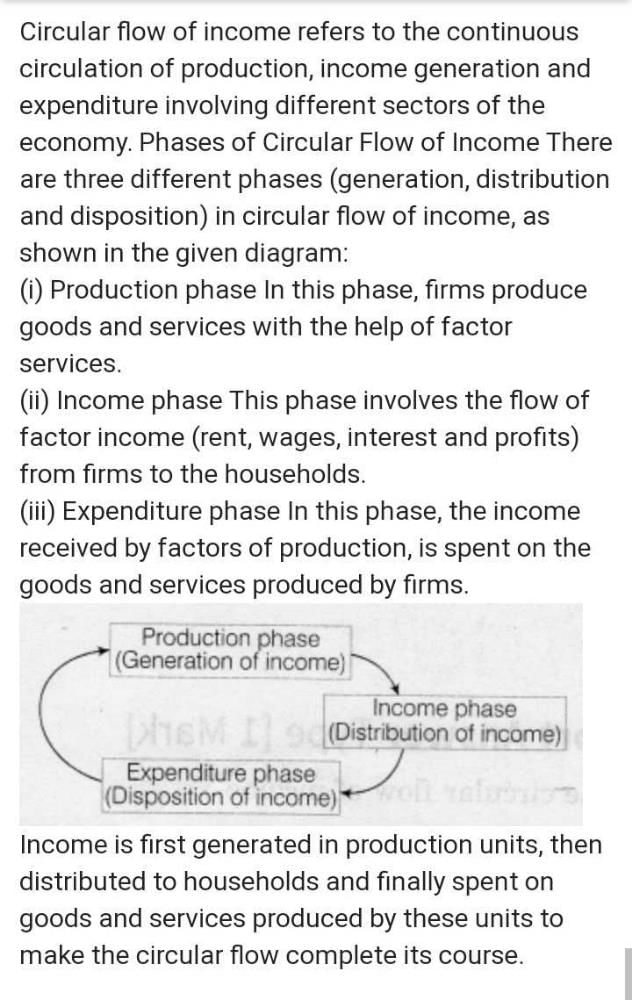Class 12 Exam > Class 12 Questions > Explain the three phases of the circular Flow...
Start Learning for Free
Explain the three phases of the circular Flow of income?
Most Upvoted Answer
Explain the three phases of the circular Flow of income?

Community Answer
Explain the three phases of the circular Flow of income?
Introduction:
Circular flow of income is a model which shows how money circulates in an economy between households, firms and the government. This model helps to understand the flow of money and goods in an economy.
Three Phases of the Circular Flow of Income:
1. Product Market:
The product market is the first phase of the circular flow of income. In this phase, households buy goods and services from the firms. The firms produce goods and services and sell them to the households. The households pay money to the firms for the goods and services they buy. This money is the revenue for the firms.
2. Factor Market:
The factor market is the second phase of the circular flow of income. In this phase, the firms buy resources from the households. The households provide resources like labor, capital, land, and entrepreneurship to the firms. In return, the firms pay money to the households for the resources they provide. This money is the income for the households.
3. Government:
The government is the third phase of the circular flow of income. In this phase, the government collects taxes from the households and the firms. The government uses this money to provide goods and services to the households like education, healthcare, infrastructure, and defense. The government also provides subsidies to the firms to encourage them to produce more goods and services.
Conclusion:
The circular flow of income model helps to understand how money flows in an economy between households, firms, and the government. This model is essential for policymakers to make decisions like tax policies, monetary policies, and fiscal policies. The circular flow of income model also helps to understand the interdependence of the different sectors of the economy.
Circular flow of income is a model which shows how money circulates in an economy between households, firms and the government. This model helps to understand the flow of money and goods in an economy.
Three Phases of the Circular Flow of Income:
1. Product Market:
The product market is the first phase of the circular flow of income. In this phase, households buy goods and services from the firms. The firms produce goods and services and sell them to the households. The households pay money to the firms for the goods and services they buy. This money is the revenue for the firms.
2. Factor Market:
The factor market is the second phase of the circular flow of income. In this phase, the firms buy resources from the households. The households provide resources like labor, capital, land, and entrepreneurship to the firms. In return, the firms pay money to the households for the resources they provide. This money is the income for the households.
3. Government:
The government is the third phase of the circular flow of income. In this phase, the government collects taxes from the households and the firms. The government uses this money to provide goods and services to the households like education, healthcare, infrastructure, and defense. The government also provides subsidies to the firms to encourage them to produce more goods and services.
Conclusion:
The circular flow of income model helps to understand how money flows in an economy between households, firms, and the government. This model is essential for policymakers to make decisions like tax policies, monetary policies, and fiscal policies. The circular flow of income model also helps to understand the interdependence of the different sectors of the economy.

|
Explore Courses for Class 12 exam
|

|
Similar Class 12 Doubts
Explain the three phases of the circular Flow of income?
Question Description
Explain the three phases of the circular Flow of income? for Class 12 2024 is part of Class 12 preparation. The Question and answers have been prepared according to the Class 12 exam syllabus. Information about Explain the three phases of the circular Flow of income? covers all topics & solutions for Class 12 2024 Exam. Find important definitions, questions, meanings, examples, exercises and tests below for Explain the three phases of the circular Flow of income?.
Explain the three phases of the circular Flow of income? for Class 12 2024 is part of Class 12 preparation. The Question and answers have been prepared according to the Class 12 exam syllabus. Information about Explain the three phases of the circular Flow of income? covers all topics & solutions for Class 12 2024 Exam. Find important definitions, questions, meanings, examples, exercises and tests below for Explain the three phases of the circular Flow of income?.
Solutions for Explain the three phases of the circular Flow of income? in English & in Hindi are available as part of our courses for Class 12.
Download more important topics, notes, lectures and mock test series for Class 12 Exam by signing up for free.
Here you can find the meaning of Explain the three phases of the circular Flow of income? defined & explained in the simplest way possible. Besides giving the explanation of
Explain the three phases of the circular Flow of income?, a detailed solution for Explain the three phases of the circular Flow of income? has been provided alongside types of Explain the three phases of the circular Flow of income? theory, EduRev gives you an
ample number of questions to practice Explain the three phases of the circular Flow of income? tests, examples and also practice Class 12 tests.

|
Explore Courses for Class 12 exam
|

|
Signup for Free!
Signup to see your scores go up within 7 days! Learn & Practice with 1000+ FREE Notes, Videos & Tests.



















